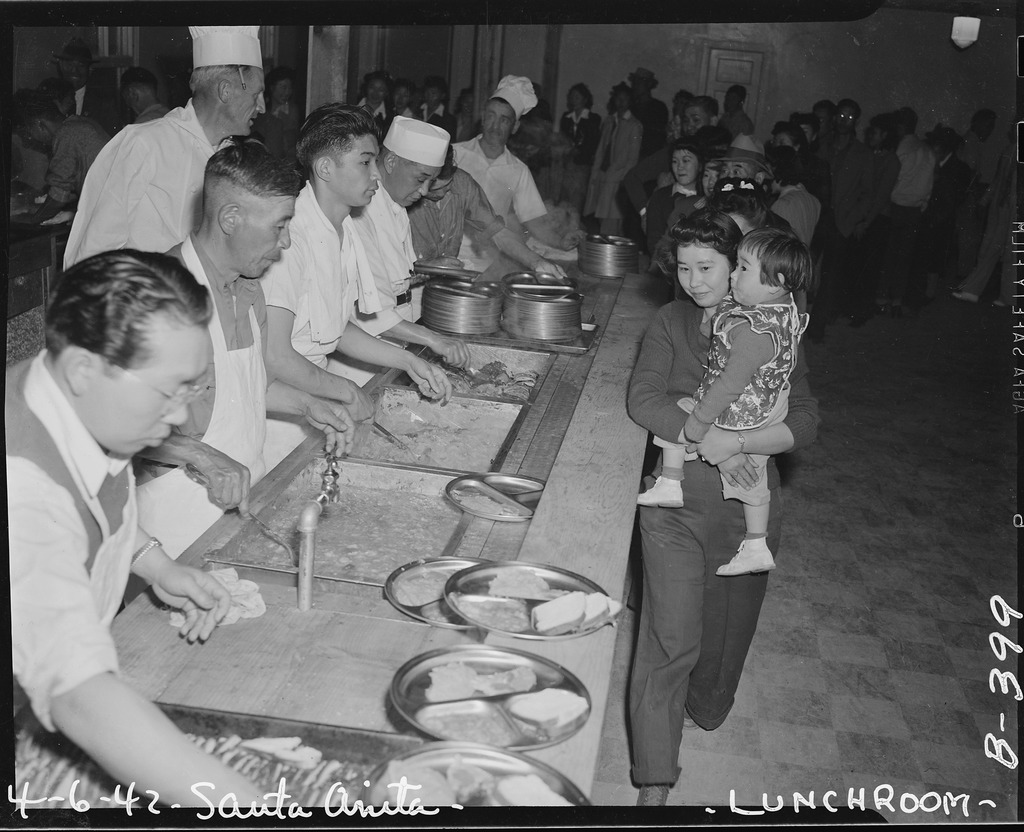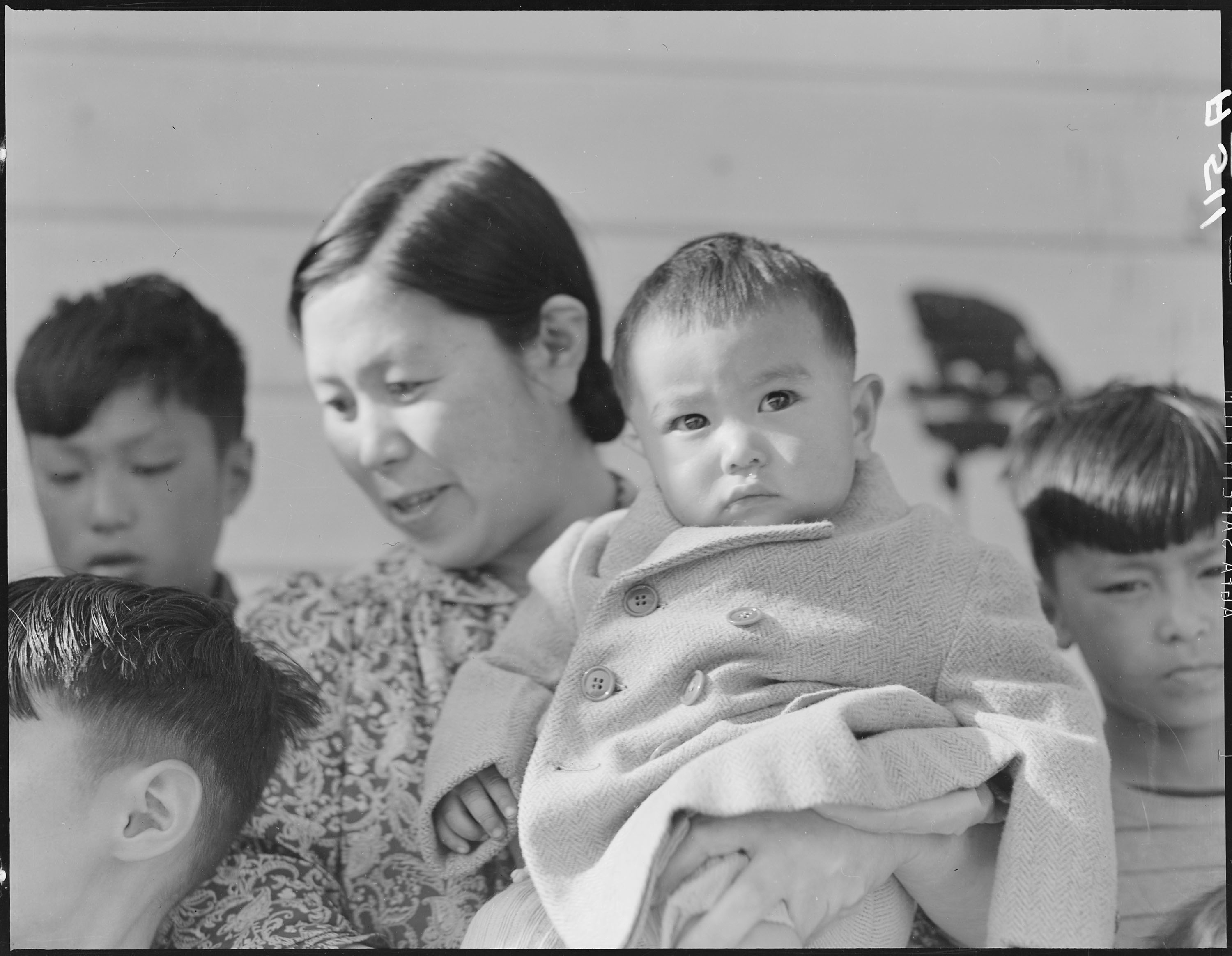October 1, 2021
Densho Content Director Brian Niiya answers a fascinating question from a 99 year old camp survivor who worked in an “assembly center” milk station providing food for infant incarcerees.
Each month(ish), Brian answers questions from Densho readers about Japanese American WWII incarceration. Want to catch up? Read his previous response to a question about where to find records on family members sent to Department of Justice internment camps.
Hannah Tani Hogan, who was incarcerated at Santa Anita and Amache during WWII and went on to pursue a career in early childhood development in Chicago, writes:
“Where may I find stories or documentation on milk stations where parents were offered food for their babies? I have a dim recollection of moms placing orders, guys delivering the milk bottles plus oatmeal and fruit selections in a jeep, and warming the glass milk bottles and other foods on a hot plate. (Once in a while, they would add a real orange for us to savor.) I worked on shifts and would appreciate more specific info as to whoever implemented this aspect in the most haunting period of my life. I am sure the parents were extremely grateful. Do you find any other ‘assembly’ centers with descriptions of milk station kiosks?”
The question raised by our 99-year-old correspondent is an interesting one that raises the larger question of how mothers, babies, and young children lived in the concentration camps — a topic for which there is minimal research.
Hannah’s memory jibes well with contemporaneous accounts. While many women breastfed their babies, camp administrators recognized the need to accommodate those who were not able to do so. Tamie Tsuchiyama, a Nisei anthropologist who was documenting conditions in the camps as a fieldworker for the Japanese American Evacuation and Resettlement project, noted in the July 31, 1942 report on Santa Anita that there were “milk stations” added “throughout the center.” As early as April 28, the camp newspaper, the Pacemaker, promised that “[t]hirty hot milk stations will be in operation soon for all babies and special diets for babies will be prepared in the stations hereafter instead of the mess halls.”
Two weeks later, an article in the Pacemaker quotes Marie Tahara, an inmate worker at one of the milk stations, describing her work. When a mother comes, Tahara would take the bottle out of the refrigerator and put it into a pan of hot water for about ten minutes. “Oftentimes the mothers engage in conversations with me. They are keen in their appreciation of the milk stations and definitely like the fact that oranges for their babies can be had for the asking.” She agreed that “the milk stations are a fine thing” and “a wonderful convenience for the mothers” and called it “a grand job” for herself. Another Pacemaker article a few days later quotes Santa Anita’s manager, Russell Amory, who states that the thirty infant feeding stations “are now supplied with a complete line of cereals, strained vegetables and chopped vegetables. Smaller infants receive milk, orange juice, and formulas prepared at the hospital by trained dieticians and supplied to the milk stations.” In a 2009 interview, Yukiko Miyahara remembered the stations as being “between the barracks in Santa Anita,” while Kanji Sahara’s sister worked in one of the stations, which he recalled were “like, four feet by four feet in size.”
Given the poor overall conditions at Santa Anita and the administrative control of the camp paper, though, one must take these glowing assessments with a grain of salt. Another Pacemaker article notes complaints by mothers about long waiting times at the stations, which Dr. Norman Kobayashi blames on the “lack of cooperation by mothers in not returning bottles promptly.” Tsuchiyama’s report notes the desire of some mothers to prepare their kids’ meals in their barrack quarters on hot plates and the protest by a group of “irate mothers” when hot plates were confiscated. The administration eventually relented and allowed hot plates for families with young children or the elderly. A later confiscation of hot plates was one of the precipitating factors in the August 4 “riot” at Santa Anita.

I wasn’t able to find much information on the other assembly centers, though all seemed to have some provision for providing formula for babies. At Tanforan, for instance, a formula kitchen under the direction of Harue Yamashita was located in the grandstand mess hall and later moved to the hospital complex. “Boys” delivered the formula to the mess halls every day, where mothers picked it up, along with special meals for children. Pomona also had “milk stations” that also served “jelly and jam sandwiches” and fruit to older children.
The WRA had to figure out how to handle the feeding of babies once inmates moved to its camps. As with many aspects of concentration camp life, the early weeks were particularly difficult as physical facilities and internal processes were often incomplete.
At his job in the Gila River housing office, Charles Kikuchi encountered many distressed inmates as they arrived from the assembly centers. In October of 1942, he encountered a man who had arrived from Santa Anita who “came in this morning very agitated that his baby had no food for two days and he was ready to crack some skulls with a two by four. He was yelling and pounding away that he was going to kill somebody if his child became ill.” As the man and his family had left Santa Anita, he had been promised that formula stations would be ready for them, but upon arrival at Gila, none were. Kikuchi took the angry man to the hospital where “blew his top and yelled all over the place.” He eventually calmed down when the head nurse immediately took steps to open a formula kitchen.
While milk/formula distribution was eventually organized at the various WRA camps, the mechanism of how to best accomplish this was an ongoing issue. Administrators sought to consolidate “special” kitchens that prepared food for those who required special diets as well as for babies in a central location such as a hospital — presumably to save money — while inmates pushed for multiple outlets and even the option to prepare formula in their barrack rooms.
Inmate protest and activism drove many changes and prevented others. At Topaz, for example, attempts by the administration to move responsibility for preparing formula to individual mothers/families in April 1943 was met by resistance by inmate leaders. Mothers cited the inadequacy of hot plates that were “too weak, too small, or too worn-down” to safely sanitize bottles and cited the hardship of using the coal stoves to heat water in the summer heat. Community Council health committee chairman Saiki Muneno argued that keeping the formula kitchens intact was worthy of “[m]eetings and mass meetings… and if necessary to the extent of a demonstration.” The administration subsequently backed down. At Gila, the shifting of the formula kitchens from the blocks to the hospital led to complaints at a 1944 block managers meeting, citing the difficulties mothers with small children faced in having to go to the hospital to pick up baby food and milk. “Couldn’t a solution be worked out so that they may receive their milk and food in their respective blocks mess?”
And as with other elements of camp life, accommodations for those who needed special care were largely not met. Aiko Herzig-Yoshinaga‘s baby girl was allergic to the powdered milk that was provided and needed canned milk, which was not available. “So my daughter suffered tremendously. She was hospitalized in the camp, went in and out, in and out, with stomach disorders because of her inability to, to get this milk, which was, of course, the lifeline for infants at the time,” she recalled in a 1994 interview. Helen Mori recalled having to make a special formula in the barracks for her baby brother, who was also allergic to the provided formula.
This is another topic about life in the concentration camps for which there is much more to learn. Do you have stories about the feeding of infants in the concentration camps?
—
By Brian Niiya, Densho Content Director
Have a question for Brian? Send it to info@densho.org or leave a comment!
[Header: An Issei woman and her children awaiting mass removal in San Francisco, 1942. Photo by Dorothea Lange, courtesy of the National Archives and Records Administration.]
References
- Tamie Tsuchiyama, “A Preliminary Report on Japanese Evacuees at Santa Anita Assembly Center,” July 31, 1942, p. 9, Japanese American Evacuation and Resettlement Records, Bancroft Library, University of California at Berkeley (JAERR subsequently), BANC MSS 67/14 c, folder B8.05, http://digitalassets.lib.berkeley.edu/jarda/ucb/text/cubanc6714_b022b08_0005.pdf; Santa Anita Pacemaker, Apr. 28, 1942, p. 3.
- Santa Anita Pacemaker, May 15, 1942, p. 3 and May 19, 1942, p. 1; Yukiko Miyahara Interview by Kirk Peterson, Segment 8, San Diego, California, Apr. 10, 2009, Manzanar National Historic Site Collection, Densho Digital Archive, https://ddr.densho.org/media/ddr-manz-1/ddr-manz-1-62-8-transcript-a1b150b68c.htm; Kanji Sahara interview by Brian Niiya, Segment 9, Torrance, California, Oct. 5, 2018, Densho Visual History Collection, Densho Digital Archive, https://ddr.densho.org/media/ddr-densho-1000/ddr-densho-1000-448-9-transcript-35b76b2dd8.htm.
- Santa Anita Pacemaker, July 4, 1942, p. 3; Tsuchiyama, “A Preliminary Report,” 9.
- Tanforan Totalizer, June 27, 1942, p .6 and Aug. 8, 1942, p. 3; Pomona Center News, May 29, 1942, p. 4.
- Charles Kikuchi diary, Oct. 21, 1942, pp. 955–56, JAERR BANC MSS 67/14 c, folder W 1.80:07**http://digitalassets.lib.berkeley.edu/jarda/ucb/text/cubanc6714_b303w01_0080_07.pdf.
- Susan McKay, The Courage Our Stories Tell: The Daily Lives and Maternal Child Health Care of Japanese American Women at Heart Mountain (Powell, Wyoming: Western History Publications, 2002), 144–45; “Closing Hospital Report,” Topaz, p. 42, JAERR BANC MSS 67/14 c, folder H12.00:7, https://oac.cdlib.org/ark:/13030/k6bp08s1/?brand=oac4; Evelyn Kirimura, “The Hospital and the General Health Program at Topaz,” [July 1944], pp. 41–45, Projects Reports Division Historical Section, JAERR BANC MSS 67/14 c, folder H2.02:55, https://oac.cdlib.org/ark:/13030/k6k93fh1/?brand=oac4; Block Managers’ meeting minutes, Mar. 16, 1943, JAERR BANC MSS 67/14 c, folder K2.20:2, https://oac.cdlib.org/ark:/13030/k6891cx1/?brand=oac4; Block Managers’ meeting minutes, Feb. 29, 1944, JAERR BANC MSS 67/14 c, folder K2.20:3, https://oac.cdlib.org/ark:/13030/k64j0n58/?brand=oac4.
- Aiko Herzig-Yoshinaga Interview by Emiko Omori (primary) and Chizu Omori (secondary), Segment 9, San Francisco, California, Mar. 20, 1994, Emiko and Chizuko Omori Collection, Densho Digital Archive, https://ddr.densho.org/media/ddr-densho-1002/ddr-densho-1002-8-10-transcript-86f4a7cb1f.htm; Helen Mori interview by Richard Potashin, Segment 10, Concord, California, Apr. 14, 2010, Manzanar National Historic Site Collection, Densho Digital Archive, https://ddr.densho.org/media/ddr-manz-1/ddr-manz-1-92-10-transcript-2c99869f61.htm.
